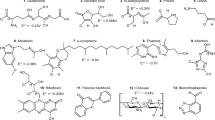Abstract
Nitrogen fertilization resulted in a linear increase in the growth ofAbies grandis seedlings, but linear decrease in foliage concentrations of phenolic compounds. These data are consistent with the inverse relationship between growth and production of carbonbased secondary chemicals predicted by the carbon/nutrient balance (CNB) hypothesis. However, in contrast to predictions of the CNB hypothesis, nitrogen fertilization had no effect on foliage terpene concentrations. The results suggest that not all carbon-based chemicals respond in the same manner to environmental variation, and that the carbon/nutrient balance hypothesis does not adequately explain all patterns of environmentally-induced variation in secondary metabolism.
Similar content being viewed by others
References
Agren GI (1985) Theory for growth of plants derived from the nitrogen productivity concept. Phys Plant 64:17–28
Berenbaum MR, Zangerl AR (1988) Stalemates in the coevolutionary arms race: syntheses, synergism, and sundry other sins. Pp 113–132in Spencer KC (ed.) Chemical Mediation of Coevolution. San Diego/CA: Academic Press
Bjorkman C, Larsson S, Gref R (1991) Effects of nitrogen fertilization on pine needle chemistry and sawfly performance. Oecologia 86:202–209
Bryant JP, Chapin FS, Klein DR (1983) Carbon/nutrient balance of boreal plants in relation to vertebrate herbivory. Oikos 40:357–368
Bryant JP, Chapin FS, Reichardt PB, Clausen TP (1987) Response of winter chemical defense in Alaska paper birch and green alder to manipulation of plant carbon/nutrient balance. Oecologia 72:510–517
Campbell RK (1979) Genecology of Douglas-fir in a watershed in the Oregon Cascades. Ecology 60:1036–1050
Chapin FS (1980) The mineral nutrition of wild plants. Annu Rev Ecol Syst 11:233–260
Chapin FS, Bloom AJ, Field CB, Waring RH (1987) Plant responses to multiple environmental factors. BioScience 37:49–57
Chew V (1976) Comparing treatment means: a compendium. Hort Sci 11:348–357
Conover WJ (1971) Practical Nonparametric Statistics. New York: John Wiley
da Cunha A (1987) The estimation of L-phenylalanine ammonialyase shows phenylpropanoid biosynthesis to be regulated by L-phenylalanine supply and availability. Phytochemistry 26:2723–2727
Fretz TA (1976) Effect of photoperiod and nitrogen on the composition of foliar monoterpenes ofJuniperus horizontalis Moench cv Plumosa. J Amer Soc Hort Sci 101:611–613
Gershenzon J (1984) Changes in the levels of plant secondary metabolites under water and nutrient stress. Pp 273–320in Timmerman BN, Steelink C, Loewus FA (eds) Phytochemical Adaptation to Stress. New York: Plenum Press
Glyphis JP, Puttick GM (1989) Phenolics, nutrition and insect herbivory in some garrigue and maquis plant species. Oecologia 78:259–263
Hagerman AE, Butler LG (1989) Choosing appropriate methods and standards for assaying tannin. J Chem Ecol 15:1795–1810
Hanover JR (1966) Genetics of terpenes. I. Gene control of monoterpene levels ofPinus monticola Dougl. Heredity 21:73–84
Herms DA, Mattson WJ (1992) The dilemma of plants: to grow or defend. Quart Rev Biol 67:283–335
Larsson S, Wiren A, Lundgren L, Ericsson T (1986) Effects of light and nutrient stress on leaf phenolic chemistry ofSalix dasyclados and susceptibility toGallerucella lineola (Coleoptera). Oikos 47:205–210
Margna U (1977) Control at the level of substrate supply — an alternative in the regulation of phenyl propanoid accumulation in plant cells. Phytochemistry 16:419–426
Margna U, Margna E, Vainjarv T (1989) Influence of nitrogen nutrition on the utilization of I-phenylalanine for building flavonoids in buckwheat seedling tissues. J Plant Physiol 134:697–702
Mattson WJ (1980) Herbivory in relation to plant nitrogen content. Annu Rev Ecol Syst 11:119–161
Mattson WJ, Haack RA (1987) The role of drought in provoking outbreaks of phytophagous insects. Pp 365–407in Barbosa P, Schultz JC (eds) Insect Outbreaks. New York: Academic Press
Mihaliak CA, Lincoln DE (1985) Growth pattern and carbon allocation to volatile leaf terpenes under nitrogen-limiting conditions inHeterotheca subaxillaris (Asteraceae). Oecologia 66:423–426
Mihaliak CA, Couvet D, Lincoln DE (1987) Inhibition of feeding by a generalist insect due to increased volatile leaf terpenes under nitrate limited conditions. J Chem Ecol 13:2059–2067
Mihaliak CA, Gershenzon J, Croteau R (1991) Lack of rapid monoterpene turnover in rooted plants: implication for theories of plant defense. Oecologia 87:373–376
Mize CW, Schultz RC (1985) Comparing treatment means correctly and appropriately. Can J For Res 15:1142–1148
Muzika RM (1989) Carbon allocation and secondary metabolites inAbies grandis as influenced by nitrogen fertilization and seed source. Doctoral dissertation, Michigan State University, East Lansing, Michigan, USA
Muzika RM, Pregitzer KS, Hanover JW (1989) Changes in terpene production with fertilization of grand fir (Abies grandis) seedlings. Oecologia 80:485–489
Price PW, Waring GL, Julkunen-Tiitto R, Tahvanainen J, Mooney HA, Craig TP (1989) Carbon-nutrient balance hypothesis in within species phytochemical variation ofSalix lasiolepis. J Chem Ecol 15:1117–1131
Rehfeldt GE (1984) Microevolution of conifers in the northern Rocky Mountains: a view from common gardens. Pp 132–146in Lanner RM (ed.) Proc Eighth North Amer Forest Biol Workshop
Reichardt PB, Chapin FS, Bryant JP, Mattes BR, Clausen TP (1991) Carbon/nutrient balance as a predictor of plant defense in Alaskan balsam poplar: potential importance of metabolite turnover. Oecologia 88:401–406
SAS Institute Inc (1987) SAS User's Guide: Statistics. Cary, North Carolina, USA
Singleton VL, Rossi JA (1965) Colorimetry of total phenolic with phosphomolybdic-phosphotungstic acid reagents. Amer J Enol Vit 16:144–158
Thorin J, Nommik H (1974) Monoterpene composition of cortical oleoresin from different clones ofPinus sylvestris. Phytochemistry 13:1879–1882
Torssell KBG (1983) Natural Products Chemistry. New York: John Wiley
Tuomi J (1992) Toward integration of plant defense theories. Trends Ecol Evol 7:365–367
Waring RH, McDonald AJS, Larsson S, Ericsson T, Wiren A, Arwidsson E, Ericsson A, Lohammar T (1985) Differences in chemical composition of plants grown at constant relative growth rates with stable mineral nutrition. Oecologia 66:157–160
Waterman PG, Mole S (1989) Extrinsic factors influencing the production of secondary metabolites in plants. Pp 107–134in Bernays EA (ed.) Insect-Plant Interactions. Vol. 1. Boca Raton/FL: CRC Press
Author information
Authors and Affiliations
Rights and permissions
About this article
Cite this article
Muzika, RM. Terpenes and phenolics in response to nitrogen fertilization: A test of the carbon/nutrient balance hypothesis. Chemoecology 4, 3–7 (1993). https://doi.org/10.1007/BF01245890
Issue Date:
DOI: https://doi.org/10.1007/BF01245890




